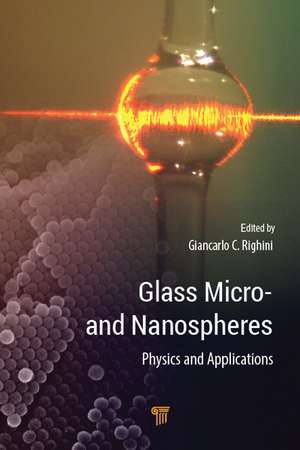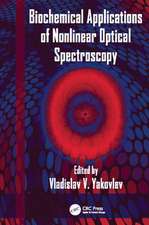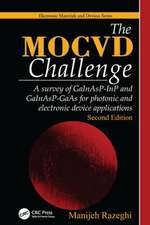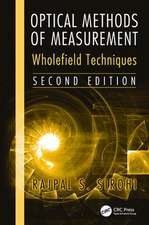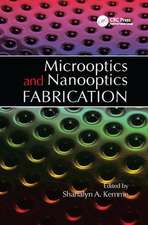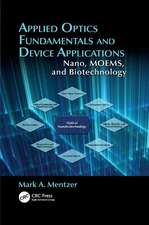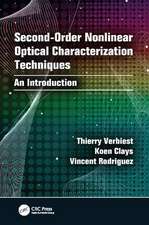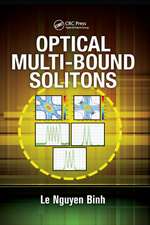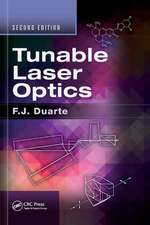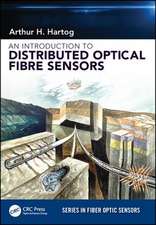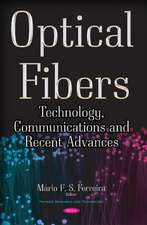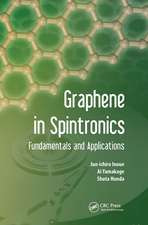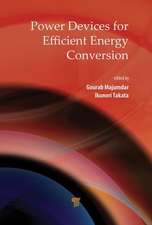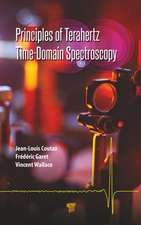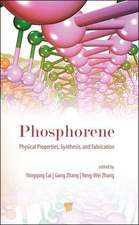Glass Micro- and Nanospheres: Physics and Applications
Editat de Giancarlo C. Righinien Limba Engleză Hardback – 28 aug 2019
Preț: 791.05 lei
Preț vechi: 1060.26 lei
-25% Nou
Puncte Express: 1187
Preț estimativ în valută:
151.38€ • 164.38$ • 127.16£
151.38€ • 164.38$ • 127.16£
Carte tipărită la comandă
Livrare economică 23 aprilie-07 mai
Preluare comenzi: 021 569.72.76
Specificații
ISBN-13: 9789814774635
ISBN-10: 9814774634
Pagini: 362
Ilustrații: 126
Dimensiuni: 152 x 229 mm
Greutate: 0.71 kg
Ediția:1
Editura: Jenny Stanford Publishing
Colecția Jenny Stanford Publishing
ISBN-10: 9814774634
Pagini: 362
Ilustrații: 126
Dimensiuni: 152 x 229 mm
Greutate: 0.71 kg
Ediția:1
Editura: Jenny Stanford Publishing
Colecția Jenny Stanford Publishing
Public țintă
Academic, Postgraduate, and Professional Practice & DevelopmentCuprins
Glass Microspheres as Optical Resonators. Glass Nanospheres and Photonic Crystals. Glass Nanospheres and Artificial Opals. Coating of Glass Microspheres. Biomedical Sensing Applications of Microspherical Resonators. Optical Frequency Conversion in Microspheres. Applications of Optical WGM Microresonators to Microwaves and Millimeter Waves. Applications of Glass Micro- and Nanospheres.
Notă biografică
Giancarlo C. Righini is a physicist. He worked for almost 40 years at CNR, the National Research Council of Italy, in Florence and Rome, becoming research director of various organizations. After his retirement from CNR, he was director of the Enrico Fermi Centre in Rome (2012–2016). His interests concern optical holography, fiber and integrated optics, and glass materials. He has published over 500 papers and has been chair of several committees of international conferences. He was vice president of IUPAP and of ICO, cofounder and president of the Italian Society of Optics and Photonics (SIOF), secretary of EOS, and member of the board of directors of SPIE. He is chair of the Technical Committee on Glasses for Optoelectronics of the ICG, fellow of EOS, OSA, SIOF, and SPIE, and a meritorious member of SIF.
Recenzii
"The editor and his collaborating authors have written a state-of-the-art reference on micro- and nanospheres with applications in physics. This useful book should be of interest to graduate students in physics, optics and biomedical engineering as well as researchers involved with nanotechnology.
Beyond an introduction to whispering-gallery modes (WGMs), which are necessary for light coupling in glass microspheres as optical resonators, the reader can easily progress to applications in high-resolution biosensing for detecting molecules, viruses and biomarkers. Application-oriented readers will also benefit from a chapter on optical WGM micro-resonators applied to microwaves and millimeter waves, as well as from sections on energy applications of glass microspheres that address hydrogen storage and targets for nuclear fusion.
Additional topics include optical frequency conversion in microspheres, like third-order sum–frequency generation and chemical synthesis of dielectric nanospheres, such as gold silica nanospheres for artificial opals as well as coatings for sensing applications. Furthermore, the development of microsphere lasers, glass beads and ball lenses should attract a wide readership." - Axel Mainzer Koenig, CEO, Mainzer Koenig Research Associates, USA.
"Editor/author Righini (emer., Institute of Applied Physics, Florence) provides historical context for development of glass micro- and nanospheres in his brief introduction, followed by detailed and current overviews of their applications, presented in eight chapters, each coauthored with a different research group. Chapters cover theoretical concepts and a wide range of applications. These include technologies as common as glass beads for signals and road marking, and as “high tech” as whispering-gallery mode resonators or sensors for biomarker detection. This is not a “teaching” textbook, but it will be useful to the advanced scientist in any of the specific areas covered. Each chapter provides its own reference section, while the common index allows readers to quickly locate information about a specific topic throughout the book. Overall the text is well written and the print quality is high. However, a number of graphs, pictures, and subscripts in equations are far too small, and one can barely read the details shown. Several graphs could be improved through use of color to distinguish particular lines or sets of data points. The text is rich in formulas and equations. Unfortunately, none of the chapters provides a general index of abbreviations, and while most symbols are self-explanatory, some are simply not explained." - H. Giesche, Alfred University, USA
"The editor and his collaborating authors have written a state-of-the-art reference on micro- and nanospheres with applications in physics. This useful book should be of interest to graduate students in physics, optics and biomedical engineering as well as researchers involved with nanotechnology.
Beyond an introduction to whispering-gallery modes (WGMs), which are necessary for light coupling in glass microspheres as optical resonators, the reader can easily progress to applications in high-resolution biosensing for detecting molecules, viruses and biomarkers. Application-oriented readers will also benefit from a chapter on optical WGM micro-resonators applied to microwaves and millimeter waves, as well as from sections on energy applications of glass microspheres that address hydrogen storage and targets for nuclear fusion.
Additional topics include optical frequency conversion in microspheres, like third-order sum–frequency generation and chemical synthesis of dielectric nanospheres, such as gold silica nanospheres for artificial opals as well as coatings for sensing applications. Furthermore, the development of microsphere lasers, glass beads and ball lenses should attract a wide readership." - Axel Mainzer Koenig, CEO, Mainzer Koenig Research Associates, USA.
"Editor/author Righini (emer., Institute of Applied Physics, Florence) provides a historical context for development of glass micro- and nanospheres in his brief introduction, followed by detailed and current overviews of their applications, presented in eight chapters, each coauthored with a different research group. The chapters cover theoretical concepts and a wide range of applications. These include technologies as common as glass beads for signals and road marking, and as "high tech" as whispering-gallery mode resonators or sensors for biomarker detection. Each chapter provides its own reference section, while the common index allows readers to quickly locate information about a specific topic throughout the book. Overall the text is well written and the print quality is high. The text is rich in formulas and equations." - H. Giesche, Alfred University, USA
Beyond an introduction to whispering-gallery modes (WGMs), which are necessary for light coupling in glass microspheres as optical resonators, the reader can easily progress to applications in high-resolution biosensing for detecting molecules, viruses and biomarkers. Application-oriented readers will also benefit from a chapter on optical WGM micro-resonators applied to microwaves and millimeter waves, as well as from sections on energy applications of glass microspheres that address hydrogen storage and targets for nuclear fusion.
Additional topics include optical frequency conversion in microspheres, like third-order sum–frequency generation and chemical synthesis of dielectric nanospheres, such as gold silica nanospheres for artificial opals as well as coatings for sensing applications. Furthermore, the development of microsphere lasers, glass beads and ball lenses should attract a wide readership." - Axel Mainzer Koenig, CEO, Mainzer Koenig Research Associates, USA.
"Editor/author Righini (emer., Institute of Applied Physics, Florence) provides historical context for development of glass micro- and nanospheres in his brief introduction, followed by detailed and current overviews of their applications, presented in eight chapters, each coauthored with a different research group. Chapters cover theoretical concepts and a wide range of applications. These include technologies as common as glass beads for signals and road marking, and as “high tech” as whispering-gallery mode resonators or sensors for biomarker detection. This is not a “teaching” textbook, but it will be useful to the advanced scientist in any of the specific areas covered. Each chapter provides its own reference section, while the common index allows readers to quickly locate information about a specific topic throughout the book. Overall the text is well written and the print quality is high. However, a number of graphs, pictures, and subscripts in equations are far too small, and one can barely read the details shown. Several graphs could be improved through use of color to distinguish particular lines or sets of data points. The text is rich in formulas and equations. Unfortunately, none of the chapters provides a general index of abbreviations, and while most symbols are self-explanatory, some are simply not explained." - H. Giesche, Alfred University, USA
"The editor and his collaborating authors have written a state-of-the-art reference on micro- and nanospheres with applications in physics. This useful book should be of interest to graduate students in physics, optics and biomedical engineering as well as researchers involved with nanotechnology.
Beyond an introduction to whispering-gallery modes (WGMs), which are necessary for light coupling in glass microspheres as optical resonators, the reader can easily progress to applications in high-resolution biosensing for detecting molecules, viruses and biomarkers. Application-oriented readers will also benefit from a chapter on optical WGM micro-resonators applied to microwaves and millimeter waves, as well as from sections on energy applications of glass microspheres that address hydrogen storage and targets for nuclear fusion.
Additional topics include optical frequency conversion in microspheres, like third-order sum–frequency generation and chemical synthesis of dielectric nanospheres, such as gold silica nanospheres for artificial opals as well as coatings for sensing applications. Furthermore, the development of microsphere lasers, glass beads and ball lenses should attract a wide readership." - Axel Mainzer Koenig, CEO, Mainzer Koenig Research Associates, USA.
"Editor/author Righini (emer., Institute of Applied Physics, Florence) provides a historical context for development of glass micro- and nanospheres in his brief introduction, followed by detailed and current overviews of their applications, presented in eight chapters, each coauthored with a different research group. The chapters cover theoretical concepts and a wide range of applications. These include technologies as common as glass beads for signals and road marking, and as "high tech" as whispering-gallery mode resonators or sensors for biomarker detection. Each chapter provides its own reference section, while the common index allows readers to quickly locate information about a specific topic throughout the book. Overall the text is well written and the print quality is high. The text is rich in formulas and equations." - H. Giesche, Alfred University, USA
Descriere
This monograph is unique compared with its equivalents in the market in respect of its scope as it contains introductory sections to most of the important topics on nanomaterials optics. This feature broadens its readership from engineers and researchers, working in the field of materials science and optics.
